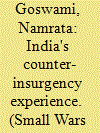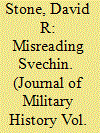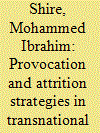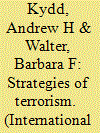|
|
|
Sort Order |
|
|
|
Items / Page
|
|
|
|
|
|
|
| Srl | Item |
| 1 |
ID:
091489


|
|
|
|
|
| Publication |
2009.
|
| Summary/Abstract |
The Indian Army, a force trained primarily for conventional warfare, has been engaged in internal counter-insurgency operations since the 1950s. Despite such a long innings on a counter-insurgency mode, little attention has been accorded within military circles to doctrinal innovation for waging sub-conventional warfare in India's democratic political context. At best, the Army continues to view counter-insurgency duty as secondary to its primary duty of defending India from external conventional threats. By conceptualizing a counter-insurgency strategy of 'trust and nurture', this article aims to fill this critical doctrinal gap in India's military policy. The author argues that a counter-insurgency strategy of 'trust and nurture' based on democratic political culture, measured military methods, special counter-insurgency forces, local social and cultural awareness and an integrative nation-building approach will result in positive handling of India's internal security problems. The author utilizes India's counter-insurgency experiences in Assam, Mizoram, Nagaland, Punjab, and Operation 'Sadhbhavana' in Jammu and Kashmir as illustrative empirical indicants in order to validate the 'trust and nurture' strategy.
|
|
|
|
|
|
|
|
|
|
|
|
|
|
|
|
| 2 |
ID:
097041


|
|
|
| 3 |
ID:
116784


|
|
|
|
|
| Publication |
2012.
|
| Summary/Abstract |
Soviet military theorist Aleksandr Svechin is often misperceived as an advocate of strategies of attrition over destruction or annihilation. In fact, Svechin was an historicist, who saw the precise balance between attrition and annihilation, or defense and offense, as constantly shifting as a result of changing material circumstances. A close examination of his theoretical and historical works reveals the depth of his thinking, while his response to Russia's 1916 Brusilov Offensive shows his support for ambitious strategies of annihilation under the proper circumstances.
|
|
|
|
|
|
|
|
|
|
|
|
|
|
|
|
| 4 |
ID:
191055


|
|
|
|
|
| Summary/Abstract |
Scholars have identified a range of terrorist strategies that militant groups employ to influence intended audiences, but there is scant empirical validation. Following Kenya’s invasion of Somalia in late 2011, Al-Shabaab executed retaliatory terrorist attacks in Kenya with the strategic aim to compel the withdrawal of Kenyan troops from Somalia. Drawing on unique in-depth interviews with Al-Shabaab defectors and civilian witnesses to counterterrorism measures in Kenya, this article investigates the strategic motives underlying Al-Shabaab’s transnational terrorist operations and assesses the effect these have had on the intended audiences. The empirical findings reveal that the attrition strategy has underpinned Al-Shabaab’s major terrorist attacks (large-scale events) whilst their minor terrorist attacks (small-scale events) have been motivated by the provocation strategy, aimed at eliciting a repressive state overreaction against Kenya’s Somali and Muslim minorities. Whilst the major terrorist attacks succeeded in fomenting the Kenyan public’s anti-war views, this did not result in troop withdrawal; the minor terrorist attacks, however, engendered harsh state repression and draconian measures against Kenya’s Somali and Muslim minorities, ultimately exacerbating existing grievances and channelling fresh recruits to Al-Shabaab. This article contributes to the growing literature on terrorist strategies, offering nuanced empirical insights to understanding the strategic motives underpinning transnational terrorist campaigns. The article demonstrates that transnational terrorism campaigns are rooted in the strategic need to influence different audiences abroad. Depending on militant groups’ short- and long-term objectives, the type of attack indicates the type of terrorist strategy they will employ.
|
|
|
|
|
|
|
|
|
|
|
|
|
|
|
|
| 5 |
ID:
187244


|
|
|
|
|
| Summary/Abstract |
Russian and Soviet military theorist Aleksandr Svechin developed his theory of military art based on the two cornerstone concepts: annihilation and attrition. Yet these concepts frequently have been misunderstood by his critics, who demoted them from the strategic to the operational level. A close examination of Svechin’s legacy allows reinstating annihilation and attrition as characterizations of the overall dynamics of war rather than mere styles of warfare freely adopted by a given belligerent. When viewed in the context of operational/strategic distinction, moreover, the Soviet theorist's concepts remain as important and practically applicable today as they were in the early 20th century.
|
|
|
|
|
|
|
|
|
|
|
|
|
|
|
|
| 6 |
ID:
073825


|
|
|
|
|
| Publication |
2006.
|
| Summary/Abstract |
Terrorism is designed to change minds by destroying bodies; it is a form of costly signaling. Terrorists employ five primary strategies of costly signaling: attrition, intimidation, provocation, spoiling, and outbidding. The main targets of persuasion are the enemy and the population that the terrorists hope to represent or control. Terrorists wish to signal that they have the strength and will to impose costs on those who oppose them, and that the enemy and moderate groups on the terrorists' side cannot be trusted and should not be supported. Each strategy works well under certain conditions and poorly under others. State responses to one strategy may be inappropriate for other strategies. In some cases, however, terrorists are pursuing a combination of strategies, and the response must also work well against this combination.
|
|
|
|
|
|
|
|
|
|
|
|
|
|
|
|
| 7 |
ID:
192137


|
|
|
|
|
| Summary/Abstract |
Attrition has been both Ukraine’s and Russia’s primary approach at the tactical level. Ukraine’s preferred way of war centres on the use of artillery fire to facilitate decisive attritional effects on the opposing force, which it then exploits with manoeuvre. This is not unexpected, as most major conventional wars feature attrition as well as manoeuvre and reconstitution. Western assistance has brought Ukraine to an impressive point, but may not yield a fires advantage for Ukraine sufficient to ensure further operational breakthroughs or strategic gains. Advanced Western weapons, such as the US-supplied High Mobility Artillery Rocket System (HIMARS), have not allowed Ukraine to avoid attritional combat, particularly in its counter-offensive in Kherson. Even with more effective wide-scale combined-arms training and precision strikes, as contemplated, future Ukrainian gains are likely to be incremental and costly unless the Russian military significantly misspends combat power in its own offensive operations.
|
|
|
|
|
|
|
|
|
|
|
|
|
|
|
|
|
|
|
|
|